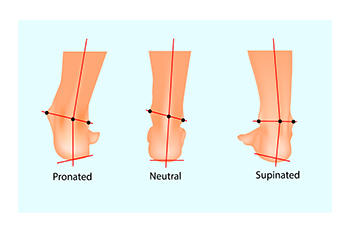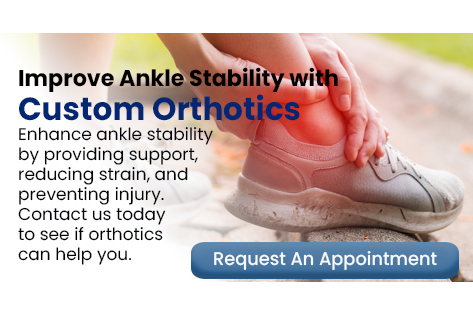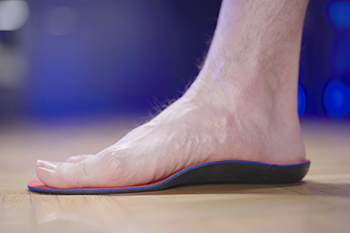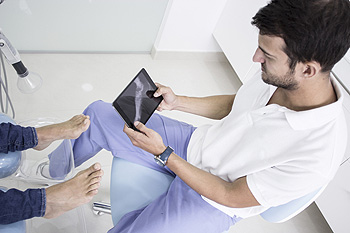Items filtered by date: March 2024
It's Time for Beautiful Feet
Causes of Overpronation

Overpronation can interfere with optimal foot health and contribute to plantar fasciitis, shin splints, and knee pain. Foot pronation and supination are natural movements that are necessary for proper gait. However, excessive pronation, characterized by prolonged inward rolling of the foot, can lead to biomechanical imbalances. One common cause of overpronation is a lack of normal ankle range of motion. When the ankle fails to bend the foot upward properly, it restricts the forward motion of the body's center of mass over the foot. This often leads to changes in gait that may lead to overpronation. A podiatrist can identify biomechanical issues contributing to overpronation and recommend personalized treatment options, such as custom orthotics to correct foot alignment and improve overall function. To address overpronation issues effectively, it is suggested that you ask a podiatrist for a thorough exam, which may include a gait analysis. A diagnosis and treatment suggestions will follow.
If you have any concerns about your feet, contact Shawn Echard, DPM from Laurel Podiatry LLC. Our practitioner can provide the care you need to keep you pain-free and on your feet.
Biomechanics in Podiatry
Podiatric biomechanics is a particular sector of specialty podiatry with licensed practitioners who are trained to diagnose and treat conditions affecting the foot, ankle and lower leg. Biomechanics deals with the forces that act against the body, causing an interference with the biological structures. It focuses on the movement of the ankle, the foot and the forces that interact with them.
A History of Biomechanics
- Biomechanics dates back to the BC era in Egypt where evidence of professional foot care has been recorded.
- In 1974, biomechanics gained a higher profile from the studies of Merton Root, who claimed that by changing or controlling the forces between the ankle and the foot, corrections or conditions could be implemented to gain strength and coordination in the area.
Modern technological improvements are based on past theories and therapeutic processes that provide a better understanding of podiatric concepts for biomechanics. Computers can provide accurate information about the forces and patterns of the feet and lower legs.
Understanding biomechanics of the feet can help improve and eliminate pain, stopping further stress to the foot.
If you have any questions please feel free to contact our offices located in Greensburg and Somerset, PA . We offer the newest diagnostic and treatment technologies for all your foot and ankle needs.
Custom Orthotics For Ankle Stability

Step with assurance, thanks to enhanced ankle stability from orthotics! If you're active and on the move, Custom Orthotics are your ally for stronger, steadier ankles. They align your foot and ankle, reducing the risk of sprains and offering solid support for every stride. Don’t let instability hold you back. Try Custom Orthotics from our office, and discover unshakable confidence in every step!
Diabetic Foot Ulcers and the Feet

Patients with diabetes face an increased risk of developing foot ulcers, or slow-healing sores, as the result of nerve damage and compromised blood circulation. Around 20 percent of people with diabetes experience a foot ulcer at some point in their lives. About half of these ulcers may become infected, which can bring serious complications, including gangrene and possibly amputation. Factors such as loss of sensation in the feet, poor circulation, and foot deformities heighten the likelihood of developing diabetic foot ulcers. Other risk factors include vision impairment, difficulty with foot care, or a prior history of ulcers. Regular foot examinations by a podiatrist are important for early detection and intervention. If you're experiencing foot problems related to diabetes, it is suggested that you make regular appointments with a podiatrist who is trained to deal with these issues.
Diabetic foot care is important in preventing foot ailments such as ulcers. If you are suffering from diabetes or have any other concerns about your feet, contact Shawn Echard, DPM from Laurel Podiatry LLC. Our practitioner can provide the care you need to keep you pain-free and on your feet.
Diabetic Foot Care
Diabetes affects millions of people every year. The condition can damage blood vessels in many parts of the body, especially the feet. Because of this, taking care of your feet is essential if you have diabetes, and having a podiatrist help monitor your foot health is highly recommended.
The Importance of Caring for Your Feet
- Routinely inspect your feet for bruises or sores.
- Wear socks that fit your feet comfortably.
- Wear comfortable shoes that provide adequate support.
Patients with diabetes should have their doctor monitor their blood levels, as blood sugar levels play such a huge role in diabetic care. Monitoring these levels on a regular basis is highly advised.
It is always best to inform your healthcare professional of any concerns you may have regarding your feet, especially for diabetic patients. Early treatment and routine foot examinations are keys to maintaining proper health, especially because severe complications can arise if proper treatment is not applied.
If you have any questions please feel free to contact our offices located in Greensburg and Somerset, PA . We offer the newest diagnostic and treatment technologies for all your foot and ankle needs.
Orthotics and Foot Health in the Workplace

Working on your feet for extended periods of time can take a toll on your lower limbs and back. Proper foot care is essential for maintaining health and comfort, regardless of your profession. Choosing the right footwear for your job is important. Flat-soled shoes may seem like a good choice, but they are not recommended for prolonged standing. Shoes should have at least a quarter inch heel elevation and provide adequate arch support. If your shoes lack enough support, speak to a podiatrist about custom-made orthotics. Ensure your shoes fit properly by getting fitted later in the day when your feet are naturally larger. This can help you make better choices when buying shoes, especially if you need arch supports or custom orthotics. Combat stiffness and pain by taking breaks to stretch your muscles and alleviate tension. Calf raises and runner's stretches can be beneficial. At home, rest your feet to reduce swelling and inflammation. Gentle foot massages with a tennis ball or baseball can relieve tightness, and elevating your feet above your heart can reduce swelling. If your foot pain worsens or persists, it is suggested that you schedule an appointment with a podiatrist as it may be a sign of an underlying condition such as bone spurs, plantar fasciitis, or fallen arches.
Custom orthotics and shoe inserts are not just for cushioning the soles; they are about supporting the foundation of our body - our feet. The advantages extend far beyond immediate relief from discomfort. These personalized solutions, that Our practitioner can prescribe, can significantly impact a person’s posture, alleviate pain in various parts of the body, and even enhance athletic performance.
As we lace up our shoes each day, having the right support can make a world of difference. Custom orthotics are like tailored suites for our feet, offering a bespoke solution to address our unique biomechanical needs. They provide stability where it is lacking, correct imbalances, and ensure that every step is a confident and pain-free one.
Custom orthotics and shoe inserts offer long-term health benefits. By addressing issues such as overpronation or underpronation, heel pain, plantar fasciitis, etc. orthotics can help prevent injuries and mitigate the progression of existing conditions. It’s an investment not just in the present, but in the future health of your feet and consequently, your overall well-being.
If you have any questions please contact our offices located in Greensburg and Somerset, PA . We offer the newest diagnostic and treatment technologies for all your foot and ankle needs.
Education Requirements for Podiatrists

Becoming a podiatrist involves rigorous educational pursuits to equip individuals with the knowledge and skills necessary for foot and ankle care. Aspiring podiatrists typically embark on a journey that includes undergraduate studies, followed by enrollment in a Doctor of Podiatric Medicine, or DPM program, accredited by the Council on Podiatric Medical Education, abbreviated CPME. These programs, spanning four years, encompass coursework in anatomy, physiology, pharmacology, and podiatric medicine, supplemented by clinical rotations and hands-on training in podiatric clinics and hospitals. Upon completing the DPM program, aspiring podiatrists undertake postgraduate training through residency programs, where they gain specialized experience in podiatric surgery, wound care, sports medicine, and other facets of foot and ankle care. Obtaining state licensure requires successful completion of national and state board examinations, ensuring competency and adherence to professional standards. Continuous education and professional development are integral to the practice of podiatry, as practitioners stay abreast of advancements and best practices to deliver quality care to their patients. If you are interested in pursuing the field of podiatry, it is suggested that you speak to this type of doctor who can answer any questions or address any concerns you may have.
If you are experiencing pain in the feet or ankles, don’t join the stubborn majority refusing treatment. Feel free to contact Shawn Echard, DPM from Laurel Podiatry LLC. Our practitioner can provide the care you need to keep you pain-free and on your feet.
What Is a Podiatrist?
Someone would seek the care of a podiatrist if they have suffered a foot injury or have common foot ailments such as heal spurs, bunions, arch problems, deformities, ingrown toenails, corns, foot and ankle problems, etc.
Podiatric Treatment
A podiatrist will treat the problematic areas of the feet, ankle or lower leg by prescribing the following:
- Physical therapy
- Drugs
- Orthotic inserts or soles
- Surgery on lower extremity fractures
A common podiatric procedure a podiatrist will use is a scanner or force plate which will allow the podiatrist to know the designs of orthotics. Patients are then told to follow a series of tasks to complete the treatment. The computer will scan the foot a see which areas show weight distribution and pressure points. The podiatrist will read the analysis and then determine which treatment plans are available.
If you have any questions please feel free to contact our offices located in Greensburg and Somerset, PA . We offer the newest diagnostic and treatment technologies for all your foot and ankle needs.
Risks Posed by Cracked Heels
 Leaving cracked heels untreated poses several risks that can affect your health. When the skin on the heels becomes excessively dry and develops calluses, it leads to deep fissures or cracks. These openings increase the risk of foot infections and leave an entry point for bacteria. Cracked heels can also lead to pain, discomfort, and difficulty walking, which may interfere with day-to-day activities. In severe cases, untreated cracked heels may result in bleeding and increase the risk of cellulitis, a serious bacterial skin infection. Foot wounds may develop when cracked heels become infected, and this is especially important to avoid for people with diabetes and the associated loss of circulation in the feet. Cracked heels may also signal underlying health issues, such as vitamin deficiencies or thyroid disorders. If you have cracked heels, it is suggested you make an appointment with a podiatrist who can treat the issue and prevent complications.
Leaving cracked heels untreated poses several risks that can affect your health. When the skin on the heels becomes excessively dry and develops calluses, it leads to deep fissures or cracks. These openings increase the risk of foot infections and leave an entry point for bacteria. Cracked heels can also lead to pain, discomfort, and difficulty walking, which may interfere with day-to-day activities. In severe cases, untreated cracked heels may result in bleeding and increase the risk of cellulitis, a serious bacterial skin infection. Foot wounds may develop when cracked heels become infected, and this is especially important to avoid for people with diabetes and the associated loss of circulation in the feet. Cracked heels may also signal underlying health issues, such as vitamin deficiencies or thyroid disorders. If you have cracked heels, it is suggested you make an appointment with a podiatrist who can treat the issue and prevent complications.
If the skin on your feet starts to crack, you may want to see a podiatrist to find treatment. If you have any concerns, contact Shawn Echard, DPM from Laurel Podiatry LLC. Our practitioner can provide the care you need to keep you pain-free and on your feet.
Cracked Heels
It is important to moisturize your cracked heels in order to prevent pain, bleeding, and infection. The reason cracked heels form is because the skin on the foot is too dry to support the immense pressure placed on them. When the foot expands, the dry skin on the foot begins to split.
Ways to Help Heal Them
- Invest in a good foot cream
- Try Using Petroleum Jelly
- Ease up on Soaps
- Drink Plenty of Water
Ways to Prevent Cracked Heels
- Moisturize After Showering
- Skip a Shower
- Keep Shower Water Lukewarm
- Don’t Scrub Your Feet
If you are unsure how to proceed in treating cracked heels, seek guidance from a podiatrist. Your doctor will help you with any questions or information you may need.
If you have any questions, please feel free to contact our offices located in Greensburg and Somerset, PA . We offer the newest diagnostic and treatment technologies for all your foot care needs.

